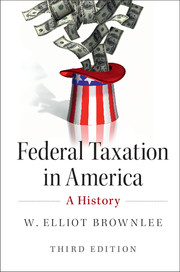Book contents
- Frontmatter
- Dedication
- Contents
- Figures
- Preface
- Acknowledgments
- 1 Anglo-American Regimes
- 2 Creating a Modern Fiscal State
- 3 The Civil War Regime
- 4 The World War I Regime
- 5 Roosevelt's Regimes
- 6 The Era of Easy Finance
- 7 “Reagan Revolution”
- 8 Fiscal Consolidation and Revival of the Old Tax Regime
- 9 Victory for a Retro-Liberal Regime
- 10 Fiscal Paralysis
- Appendix
- Historiography and Bibliography
- Index
Preface
Published online by Cambridge University Press: 05 July 2016
- Frontmatter
- Dedication
- Contents
- Figures
- Preface
- Acknowledgments
- 1 Anglo-American Regimes
- 2 Creating a Modern Fiscal State
- 3 The Civil War Regime
- 4 The World War I Regime
- 5 Roosevelt's Regimes
- 6 The Era of Easy Finance
- 7 “Reagan Revolution”
- 8 Fiscal Consolidation and Revival of the Old Tax Regime
- 9 Victory for a Retro-Liberal Regime
- 10 Fiscal Paralysis
- Appendix
- Historiography and Bibliography
- Index
Summary
“In this world nothing can be said to be certain, except death and taxes,” wrote Benjamin Franklin in 1789. I certainly agree with him regarding what my father soothingly referred to as “eventualities.” But Franklin's proverb breaks down as a way of understanding tax planning, the making of tax policy, and tax history. Well-trained tax attorneys can help some clients avoid paying any taxes on the wealth they accumulate in their lifetimes and then pass on that wealth tax free to the next generation. Skillful politicians and lobbyists can bring about huge shifts of income and wealth through changes in the tax system that produce winners and losers. And, while great national crises almost invariably produce seismic transitions in tax systems, the transitions often occur in ways that are very hard to predict. In two editions of Federal Taxation in America: A Short History, I tracked those transitions in the history of the United States and concluded that the history of taxation in the United States ought to be understood not as a process of incremental change but as a series of distinct tax regimes, each one driven by a national crisis.
Since the late 1970s, the possibility of radical reform of the federal tax system, one that would produce a new tax regime, has been a matter of intense debate. And that debate has, in fact, prompted important changes in the tax system. Of primary importance were the reforms of tax and fiscal practice undertaken during the presidency of George W. Bush and confirmed during that of Barack Obama. These reforms brought about the most significant changes in federal taxation since World War II. The reforms, I believe, have launched a new tax and fiscal regime that, for reasons discussed in this book, should be described as “retro-liberal.”
The transition to the retro-liberal regime did not take place overnight. It had roots in hostility to progressive taxation and ambitious government that dated back to World War I and even earlier. The swing toward the new regime began during the late 1970s, producing first the success of California's Proposition 13 in 1978 and President Ronald Reagan's Economic Recovery Tax Act of 1981.
- Type
- Chapter
- Information
- Federal Taxation in AmericaA History, pp. ix - xiiPublisher: Cambridge University PressPrint publication year: 2016

